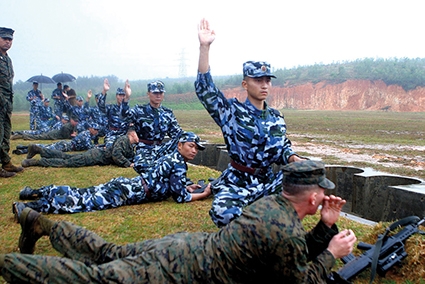China's Grand Strategy
The first goal of all successive Chinese dynasties throughout the centuries was to gain and maintain control of the heartland (Han), the core of which consists of major Chinese rivers, is abundant with productive lands and is full of people. A further logical step is maintenance of influence over the buffer zones which surround the Han core and consist of mountainous regions to the west, desert lands to the north-west and impregnable forests to the south. The third major imperative was historically to protect China’s coastline from foreign powers. However, since this threat was quite rare in the ancient and medieval periods of Chinese history, the country did not see any need to develop powerful naval capabilities. The Yangtze and Yellow rivers, with surrounding fertile lands, produced enough to feed large numbers of population living in the Han core and as such, in an age without transcontinental trade routes and the only way to connect with the Middle East and Europe being the famous Silk Road, the geographic boundaries (mountains, jungles, deserts and the sea) from all sides made China essentially a closed country with self-sufficient economic means.
In other words, where previously China’s insularity was a geopolitical advantage rather than a significant constraint, from the late 20th century this was no longer the case. With international trade routes and various supply chains, China has to be open and, in many cases, rely upon raw materials brought from abroad via sea routes. Thence comes China’s fourth geopolitical imperative: protection of international trade lines and resource hubs. This will only be viable through two options: finding alternative land routes such as One Belt, One Road or by building a powerful military fleet capable of securing various resources and global supply chains across the Asia Pacific and elsewhere.
Building a powerful navy will mean collusion with the United States, whose world primacy rests upon domination of sea lines and relevant security alliances in Europe and Asia-Pacific. Any diminution of the US sea power will have a direct impact on the world order, considering the importance which Washington attaches to developments in foreign powers’ naval capabilities. Chinese naval technology may still be substantially behind current US capabilities. Indeed, the US has 11 aircraft carriers, while the Chinese only one (which still lacks an aircraft wing capable of operating off a carrier deck). However, the trends indicate that China has been making significant progress in the last several decades, as the country is rapidly developing new destroyers, amphibs, stealth fighters and long-range weapons. This could potentially expand expeditionary military operations around the globe.
China continues to construct an array of offensive and defensive capabilities to enable the PLA to gain maritime superiority within the first island chain in Asia pacific. Those are the islands which run from the Kurils, through Taiwan, to Borneo, roughly encompassing the Yellow Sea, East China Sea, and South China Sea.
China’s broad range of anti-ship cruise missiles (ASCMs) and launch platforms, as well as submarine launched torpedoes and naval mines, allow the People’s Liberation Army Navy (PLAN) to create a lethal threat against enemies approaching Chinese waters and operating areas.
The PLAN continues to develop into a global force, gradually extending its operational reach beyond East Asia and the Indo-Pacific into a sustained ability to operate at increasingly longer ranges. The PLAN’s latest naval platforms enable combat operations beyond the reach of China’s land-based defenses.
Furthermore, the PLAN now has a sizable force of high-capability logistical replenishment ships to support long-distance, long-duration deployments, including two new ships being built specifically to support aircraft carrier operations. The expansion of naval operations beyond China’s immediate region will also facilitate non-war uses of military force.
The PLAN’s force structure continues to evolve, incorporating more platforms with the versatility for both offshore and long-distance power projection. China is engaged in series production of the LUYANG III-class DDG, the JIANGKAI II-class FFG, and the JIANGDAO-class FFL.
Even on the aircraft level, despite its numerical weaknesses, China continues to learn lessons from operating its only Ukraine-produced aircraft carrier, Liaoning. The Chinese first domestically produced aircraft carrier, launched in 2017, will be commissioned in 2019 (according to various sources this will be a multi-carrier force). China’s next generation of carriers will probably have greater endurance and be capable of launching more varied types of fixed-wing aircraft than Liaoning. There also comes PLAN Aviation’s progress on improving capabilities to conduct offensive and defensive offshore operations such as strike, air and missile defense, strategic mobility, and early warning and reconnaissance missions.
Overall, for the moment, the PLAN’s ability to perform missions beyond the first island chain is modest. What is important here is that the PLAN’s ability is constantly growing as it gains more experience operating in distant waters and acquires larger and more advanced technologies. The US will remain a dominant force in the coming decades, but Chinese successes cannot be underestimated.
Chinese naval successes, reflected in the recent congressional report, add to growing American fears that China might become a global competitor. Indeed, from the US perspective, what the Chinese are doing in Eurasia through its pivotal One Belt, One Road initiative, and various moves to influence Tajikistan, Afghanistan and Pakistan, is geopolitically important. From the US perspective, the Chinese are doing exactly what the Americans have been opposed to – solidifying one-country rule in Eurasia.
By Emil Avdaliani
Photo: PLAN Marines of the 1st Marine Brigade and members of the USMC fire the Type 95 Assault Rifle during an exchange exercise. By Lance Cpl. Jeremy J. Harper











